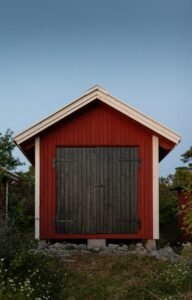Unveiling the Timeless Legacy: The History and Evolution of Sheds

Introduction
From humble beginnings as rudimentary shelters to multifunctional structures gracing modern landscapes, sheds have been woven into human history's fabric. Tracing their journey unveils a narrative of utility and reflects cultural, architectural, and technological shifts. Join us as we embark on a fascinating exploration of sheds' rich history and evolutionary journey.
Origins of Sheds
 In the annals of human civilization, the shed emerges as a primal response to the need for shelter. Early civilizations crafted simple structures using wood, thatch, and mud. These primitive shelters were protected from the elements and served as storage spaces for tools, food, and other essentials. From the Neolithic era to ancient civilizations like Mesopotamia and Egypt, evidence of rudimentary sheds underscores their indispensable role in early human settlements.
In the annals of human civilization, the shed emerges as a primal response to the need for shelter. Early civilizations crafted simple structures using wood, thatch, and mud. These primitive shelters were protected from the elements and served as storage spaces for tools, food, and other essentials. From the Neolithic era to ancient civilizations like Mesopotamia and Egypt, evidence of rudimentary sheds underscores their indispensable role in early human settlements.
As societies transitioned from nomadic lifestyles to settled agricultural communities, constructing more permanent structures became essential. The transition from temporary shelters to more robust outbuildings marked a pivotal moment in the evolution of sheds, laying the groundwork for their future development.
Sheds Through the Ages
In medieval Europe, sheds evolved into outbuildings integral to agricultural practices. Monastic gardens boasted potting sheds, while sprawling estates featured grandiose garden pavilions. We witnessed a revival of interest in classical architecture in the Renaissance, influencing shed design with symmetry and proportion. Sheds became functional structures and expressions of status and aesthetic sensibility.
The advent of colonialism and exploration brought shed-building traditions to new frontiers, intersecting with indigenous architectural practices, giving rise to unique hybrid forms. From colonial barns in America to tea sheds in colonial India, sheds adapted to diverse cultural and environmental contexts, reflecting the ingenuity and adaptability of human craftsmanship.
Cultural Importance
 Sheds are significant cultural icons of craftsmanship, self-reliance, and community. Across cultures and historical periods, sheds have served as more than functional structures; they embody traditions, values, and aspirations.
Sheds are significant cultural icons of craftsmanship, self-reliance, and community. Across cultures and historical periods, sheds have served as more than functional structures; they embody traditions, values, and aspirations.
In rural communities, sheds are often central to agricultural practices and rural livelihoods, serving as storage spaces for tools, equipment, and crops. They also contribute to the conservation of cultural heritage by maintaining traditional shed construction methods and architectural designs handed down over multiple generations.
In urban areas, sheds serve as spaces for creativity, recreation, and community engagement. Backyard sheds become retreats for relaxation and hobbies, while communal sheds host events, workshops, and gatherings. Shed culture fosters a sense of belonging and connection, celebrating the shared pursuit of craftsmanship and self-expression.
Architectural Evolution
The architectural evolution of sheds reflects changing aesthetic preferences, technological advancements, and functional requirements. Over time, sheds have evolved from simple shelters to sophisticated structures that blend form and function.
In ancient civilizations, sheds were often practical in design and characterized by simple shapes and natural materials. As societies developed, shed architecture became more diverse, incorporating elements of regional styles and cultural influences.
Technological advancements like steel and corrugated iron revolutionized shed construction during the Industrial Revolution, allowing for larger spans and more significant structural integrity. Architectural styles evolved to accommodate new materials and construction techniques, resulting in a proliferation of prefabricated sheds and standardized designs.
In the modern era, shed architecture has become more experimental and innovative, with architects and designers exploring new materials, construction methods, and spatial configurations. Contemporary shed designs prioritize sustainability, flexibility, and adaptability, reflecting broader trends in architecture and urban planning.
Industrial Revolution and Technological Advancements
With the advent of the Industrial Revolution, sheds saw a new phase marked by technological improvements and the widespread application of mass manufacturing techniques. Advancements in materials like steel and corrugated iron revolutionized shed construction, creating more significant, more durable structures. The rise of railway networks facilitated the widespread distribution of prefabricated sheds, making them accessible to rural and urban populations.
Standardizing shed components and assembly techniques streamlined construction, reducing costs and increasing efficiency. Sheds became not just functional spaces but also symbols of progress and modernity, embodying the spirit of industrialization.
Technological Advancements
 The evolution of technology has been instrumental in influencing the design and function of sheds. Technology has transformed every shed design and production aspect, from traditional handcrafted techniques to modern manufacturing processes.
The evolution of technology has been instrumental in influencing the design and function of sheds. Technology has transformed every shed design and production aspect, from traditional handcrafted techniques to modern manufacturing processes.
In ancient times, sheds were constructed using essential tools and techniques, relying on manual labour and craftsmanship. With the onset of the Industrial Revolution, the introduction of mechanization and mass production transformed the shed construction process, leading to increased speed, cost-effectiveness, and efficiency.
Introducing new materials like steel, concrete, and plastics expanded the possibilities for shed design, creating more significant, more durable structures. Prefabrication and modular construction techniques further streamlined the building process, allowing for customization and flexibility.
In recent years, digital technologies have revolutionized shed design and planning. Computer-aided design (CAD) software enables architects and designers to create intricate models and simulations. Intelligent technologies like IoT devices and sensors are also being integrated into sheds, allowing for automation, monitoring, and energy efficiency.
Sheds in the Modern Era
Sheds transcended their practical origins in the 20th and 21st centuries, becoming symbols of leisure, creativity, and self-expression. The backyard shed evolved into the man cave she shed and artist's studio, reflecting changing lifestyles and aspirations. Sustainable design practices have also influenced shed construction, with eco-friendly materials and energy-efficient features gaining prominence.
Sheds have found new life as spaces for hobbies, entrepreneurship, and community engagement. From urban rooftop gardens to rural coworking spaces, sheds continue to evolve to meet the changing needs of contemporary society.
Future Perspectives
As we look to the future, sheds continue to evolve in response to shifting societal needs and technological advancements. Concepts like intelligent sheds equipped with IoT devices for automation and monitoring hint at the potential for further innovation. Yet, amidst the march of progress, sheds remain rooted in tradition, embodying timeless principles of craftsmanship and utility.
The future of sheds holds promise for sustainable design, modular construction, and adaptive reuse. As we confront challenges like climate change and urbanization, sheds may play a crucial role in fostering resilience and sustainability in the built environment.
Key Takeaways
- Sheds as Cultural Artifacts: Sheds have played a crucial role throughout human history, evolving from simple shelters to multifunctional structures that reflect cultural, architectural, and technological advancements.
- Evolution of Shed Design: Shed design has evolved and been influenced by agricultural practices, technological innovations, and changing societal needs. Shows have adapted to diverse contexts and purposes, from medieval barns to modern backyard retreats.
- Diverse Functions: Sheds serve various functions, including storage, workspace, leisure, and community gathering spaces. Their versatility and adaptability make them indispensable elements of the built environment.
- Future Trends: The future of sheds holds promise for sustainable design, modular construction, and innovative uses. Concepts like intelligent sheds and tiny houses reflect emerging trends in shed architecture and urban planning.
- Cultural Significance: Sheds are more than just functional structures; they hold cultural significance as symbols of craftsmanship, creativity, and self-expression. Shed culture encompasses various activities and traditions, from DIY projects to communal initiatives.
Frequently Asked Questions (FAQs)
- What are the origins of sheds? Sheds originated in early human settlements, where primitive shelters were constructed using natural materials like wood, thatch, and mud. These shelters are protected against the elements and storage spaces for essential supplies.
- How have sheds evolved? Shed design has evolved from simple structures to multifunctional spaces that reflect changes in architectural styles, technological advancements, and societal needs. Medieval barns, Renaissance garden pavilions, and modern backyard retreats are examples of this evolution.
- What are some standard functions of sheds? Sheds serve various functions, including storage for tools, equipment, and supplies; workspace for hobbies, crafts, and DIY projects; leisure spaces for relaxation and recreation; and community gathering spaces for events and activities.
- What are some future trends in shed design? Future trends in shed design include sustainable construction practices, modular design solutions, and innovative uses such as intelligent sheds equipped with IoT devices. The rise of tiny houses and communal shed initiatives also reflects emerging trends in urban planning and community development.
- What is shed culture? Shed culture encompasses various activities and traditions associated with sheds, including DIY projects, woodworking, gardening, and communal initiatives like tool libraries and repair cafes. Sheds are seen as spaces for creativity, self-expression, and community engagement.
Summary Table:
| Aspect | Description |
| Origins of Sheds | Early shelters made of natural materials were used for protection and storage in ancient civilizations. |
| Sheds Through the Ages | Medieval barns, Renaissance garden pavilions, and colonial outbuildings; diverse architectural forms for various functions. |
| Industrial Revolution | Technological advancements like steel and corrugated iron revolutionized shed construction, mass production, and distribution of prefabricated sheds. |
| Sheds in the Modern Era | Transformation into leisure and creative spaces, backyard retreats, artist studios, and maker spaces reflect changing lifestyles and aspirations. |
| Future Perspectives | Trends in sustainable design, modular construction, and intelligent technology; the emergence of tiny houses and communal shed initiatives; response to urbanization and climate change. |
This table outlines the key points covered in the article, offering a summary of the historical development and progression of sheds.
Additional Resources
- "The Tool Shed Reader" by Scott D. Murray - This comprehensive book explores sheds' cultural, historical, and architectural significance worldwide, providing insights into their evolution and diverse uses.
- "Sheds: A Practical Handbook for DIY Backyard Builders," by David R. Stiles, is a comprehensive resource for individuals keen on constructing their sheds. This guide offers detailed instructions, creative design suggestions, and valuable construction insights, making it an essential companion for DIY enthusiasts embarking on shed-building projects.
- "Shedworking: The Alternative Workplace Revolution," authored by Alex Johnson, delves into the rising phenomenon of shed working. The book investigates the transformation of sheds into unique work environments catering to remote workers, freelancers, and individuals in creative professions.
- "Sally Coulthard's 'Shed Chic: Outdoor Buildings for Work, Rest, and Play'"
- - A visually stunning guide to stylish shed designs, showcasing inspirational examples of sheds used for leisure, hobbies, and relaxation.
- Online Communities: Websites like Houzz, Pinterest, and Reddit's r/DIY and r/Sheds communities offer a wealth of inspiration, ideas, and advice for shed enthusiasts, from design inspiration to construction techniques.
Conclusion
In tracing the history and evolution of sheds, we uncover a narrative that transcends mere architectural form. Sheds embody human civilization's ingenuity, resilience, and adaptability as tangible reminders of our quest for shelter, innovation, and self-expression. As we navigate the complexities of the modern world, we can find solace and inspiration in the humble yet remarkable legacy of the shed.
Tracing sheds' cultural, architectural, and technological dimensions reveals a rich tapestry of human ingenuity, creativity, and resilience. Shows embody the timeless principles of craftsmanship, self-reliance, and adaptability, from their humble origins as simple shelters to their modern-day incarnation as multifunctional spaces for work, leisure, and community.
As we navigate the complexities of the modern world, sheds offer a sanctuary amidst the chaos, a refuge for creativity, contemplation, and connection. Their cultural significance transcends mere utility, symbolizing human aspiration and endeavor.
As we look to the future, sheds hold promise as incubators of innovation, sustainability, and community resilience. Shows will evolve in response to shifting societal needs and technological advancements, whether tiny houses, urban gardens, or communal workspaces.
In celebrating the shed's humble yet remarkable legacy, let us embrace its capacity to inspire, empower, and enrich our lives. As we build, create, and gather in these timeless structures, may we find solace, inspiration, and kinship amidst the ever-changing landscape of human existence.
- Crafting Affordable Dream Sheds: Cost-Effective Solutions for You
- Affordable Outdoor Storage: Budget-Friendly Shed Alternatives
- Dont Break the Bank: Top Picks for Cheap Shed Options
- Crafting Cost-Effective Solutions: Affordable Shed Construction Explained
- Empowering Your Space: Tips for Managing Shed Construction Budget
- Unveiling Shed Building Cost Estimator: Your Budgets Best Friend
- Revamp Your Shed: Creative Shed Base Ideas for Your Outdoor Oasis
- Elevate Your Shed Game: Unveiling the Magic of Concrete Foundations
- Budget-Friendly Solutions: Exploring Prefab Shed Prices
- Step-by-Step Gravel Shed Foundation Building Made Easy

Leave a Reply
You must be logged in to post a comment.